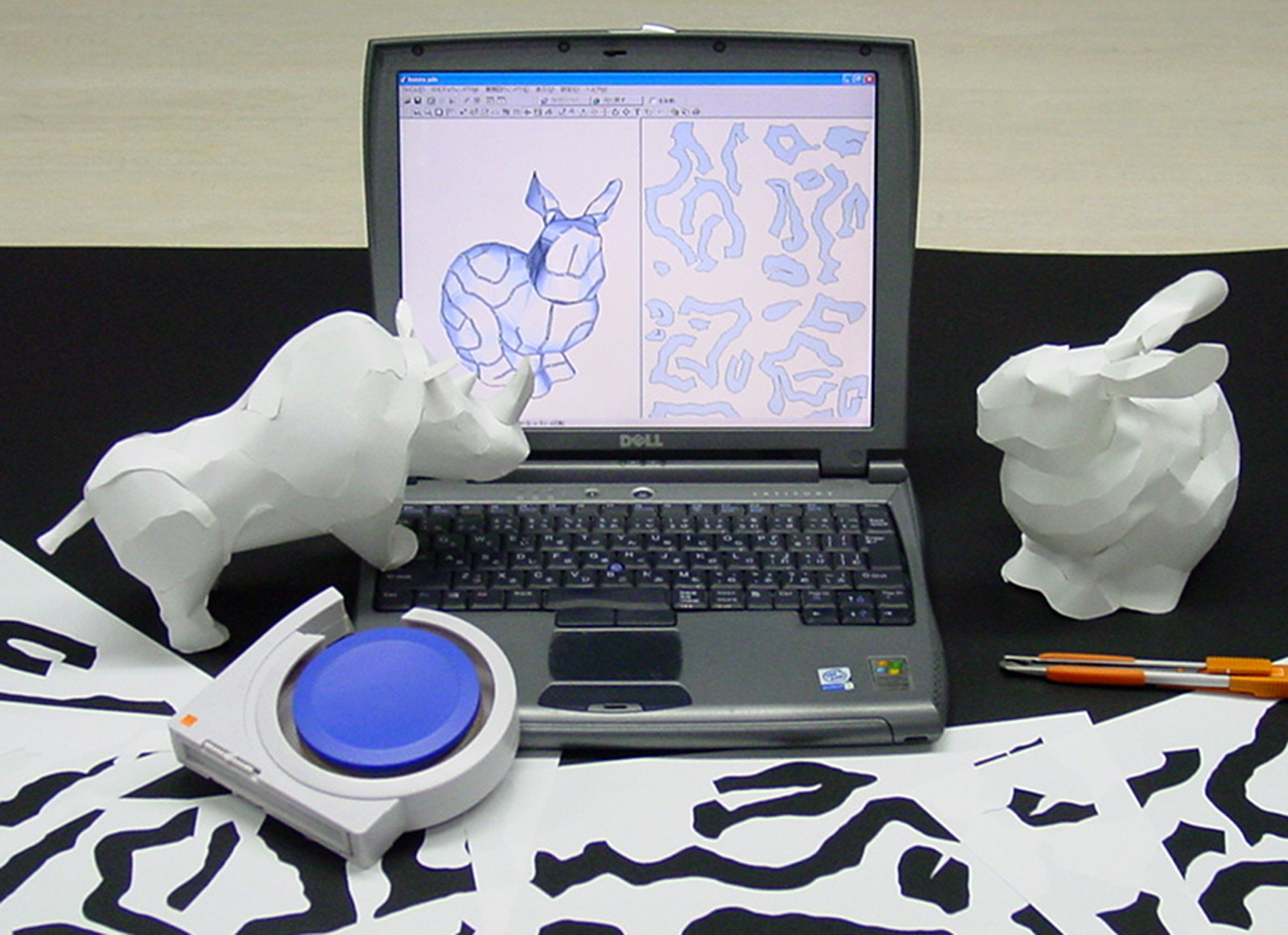“Making papercraft toys from meshes using strip-based approximate unfolding” by Mitani and Suzuki
Conference:
Type(s):
Title:
- Making papercraft toys from meshes using strip-based approximate unfolding
Presenter(s)/Author(s):
Abstract:
We propose a new method for producing unfolded papercraft patterns of rounded toy animal figures from triangulated meshes by means of strip-based approximation. Although in principle a triangulated model can be unfolded simply by retaining as much as possible of its connectivity while checking for intersecting triangles in the unfolded plane, creating a pattern with tens of thousands of triangles is unrealistic. Our approach is to approximate the mesh model by a set of continuous triangle strips with no internal vertices. Initially, we subdivide our mesh into parts corresponding to the features of the model. We segment each part into zonal regions, grouping triangles which are similar topological distances from the part boundary. We generate triangle strips by simplifying the mesh while retaining the borders of the zonal regions and additional cut-lines. The pattern is then created simply by unfolding the set of strips. The distinguishing feature of our method is that we approximate a mesh model by a set of continuous strips, not by other ruled surfaces such as parts of cones or cylinders. Thus, the approximated unfolded pattern can be generated using only mesh operations and a simple unfolding algorithm. Furthermore, a set of strips can be crafted just by bending the paper (without breaking edges) and can represent smooth features of the original mesh models.
References:
1. ABNET CORP, 2003. Pepakura Designer. http://www.e-cardmodel.com/pepakura-en/.Google Scholar
2. CHEN, H., LEE, I., LEOPOLDSEDER, S., POTTMANN, H., RANDRUP, T., AND WALLNER, J. 1999. On Surface Approximation Using Developable Surfaces. Graphical Models and Image Processing, 61, 2, 110–124Google ScholarCross Ref
3. CIGNONI, P., ROCCHINI, C., AND SCOPIGNO, R. 1998. Metro: measuring error on simplified surfaces. Compute Graphics Forum, 17, 2, 167–174Google ScholarCross Ref
4. COHEN, J. D. 1999. Concepts and Algorithms for Polygonal Simplification. SIGGRAPH 99 Course Tutorial #20, C1-C34.Google Scholar
5. ELBER, G. 1995. Model Fabrication using Surface Layout Projection. CAD 27, 4, 283–291.Google ScholarCross Ref
6. EVANS, F., SKIENA, S., AND VARSHNEY, A. 1996. Optimizing Triangle Strips for Fast Rendering. IEEE Visualization ’96, 319–326. Google ScholarDigital Library
7. GARLAND, M., AND HECKBERT, P. S. 1997. Surface simplification using quadric error metrics. In Proc. of ACM SIGGRAPH 1997, 209–216. Google ScholarDigital Library
8. GARLAND, M., WILLMOTT, A., AND HECKBERT, P. 2001. Hierarchical face clustering on polygonal surfaces. In Proc. of ACM Symposium on Interactive 3D Graphics, 49–58. Google ScholarDigital Library
9. HOPPE, H., DEROSE, T., DUCHAMP, T., MCDONALD, J., AND STUETZLE, W. 1993. Mesh Optimization. In Proc. of ACM SIGGRAPH 1993, 19–26. Google ScholarDigital Library
10. HOSCHEK, J. 1998. Approximation of surfaces of revolution by developable surfaces. CAD, 30, 10, 757–763.Google ScholarCross Ref
11. HUBELI, A., AND GROSS, M. 2001. Multiresolution features extraction from unstructured meshes. In Proc. of IEEE Visualization, 287–294. Google ScholarDigital Library
12. KATZ, S., AND TAL, A., 2003. Hierarchical mesh decomposition using fuzzy clustering and cuts. ACM Transactions on Graphics, 22, 3, 954–961. Google ScholarDigital Library
13. LÉVY, B., PETITJEAN, S., RAY, N., AND MAILLOT, J. 2002. Least squares conformal maps for automatic texture atlas generation. ACM Transactions on Graphics, 21, 3, 362–371. Google ScholarDigital Library
14. MILENKOVIC, V. J. 1999. Rotational polygon containment and minimum enclosure using only robust 2D constructions. Computational Geometry, 13, 1, 3–19. Google ScholarDigital Library
15. NEIDER, J., DAVIS, T., AND WOO, M. 1993. OpenGL Programming Guide. Addison-Wesley, 1993.Google Scholar
16. POTTMANN, H., AND FARIN, G. 1995. Developable rational Bézier and B-spline surfaces. CAGD, 12, 5, 513–531. Google ScholarDigital Library
17. SHEFFER, A. 2002. Spanning Tree Seams for Reducing Parameterization Distortion of Triangulated Surfaces. Shape Modelling International, 61–66. Google ScholarDigital Library
18. SIGGRAPH 1998. SIGGRAPH 98 Teapot Assembly. http://www.siggraph.org/s98/conference/teapot/Google Scholar
19. SORKINE, O., COHEN-OR, D., GOLDENTHAL, R., AND LISCHINSKI, D. 2002. Bounded-distortion Piecewise Mesh Parameterization. In Proc. of the conference on Visualization ’02, 355–362. Google ScholarDigital Library
20. TAUBIN, G., AND ROSSIGNAC, J. 1998. Geometric Compression Through Topological Surgery. ACM Transactions on Graphics, 17, 2, 84–115. Google ScholarDigital Library
21. TURK, G. 1992. Re-tiling Polygonal Surfaces. In Proc. of ACM SIGGRAPH 1992, 55–64. Google ScholarDigital Library





